Did you know that there are many different breeds of horses and ponies in North America? Horses first arrived in the 1500’s with Spanish explorers – and they’ve secured a place in our hearts and minds ever since. Here is are 40 of the most common horse and pony breeds that you can find in America today.
Table of Contents
American Paint Horse
Average Height: 14.2 – 16.2 hands
Common Colors: Tobiano or overo coat patterns
Type: Light horse
Common Uses: Western stock events, performance, trail riding, pleasure riding, jumping
Registry: American Paint Horse Association
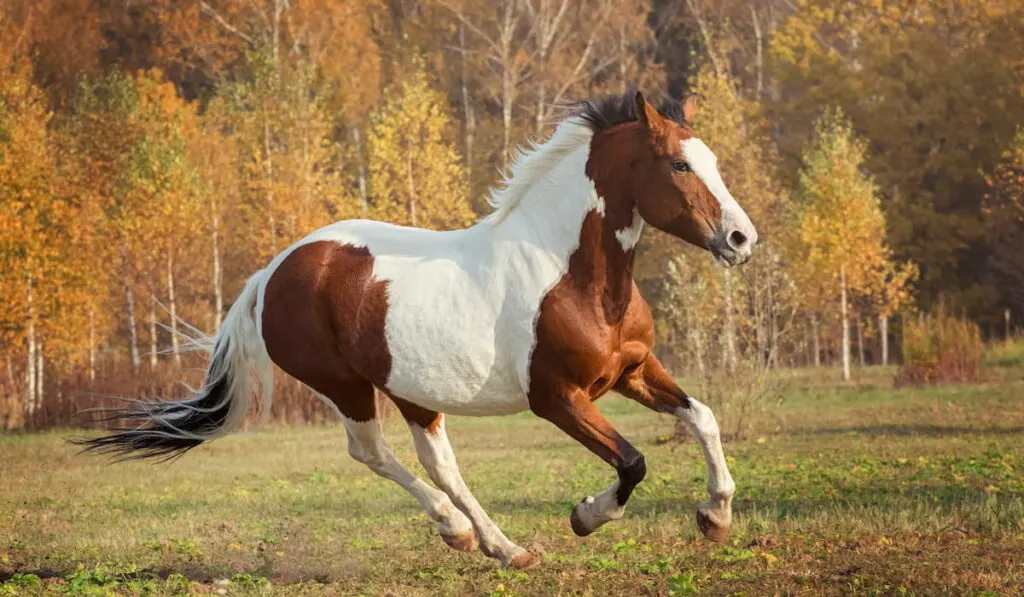
The flashy American Paint Horse is one of the most common horse breeds in America today. When our equine companions arrived in the Americas with the Spanish conquistadors, many of the indigenous tribes began adopting them into their cultures. Many of these tribes favored loud-colored animals, and settlers often caught and used wild spotted mustangs.
Eventually, breeders began selecting traits beyond just a loud coat color. Today, the American Paint Horse is a stocky athletic little horse that is well suited for a variety of disciplines. They excel at ranch work, rodeo events, but they also make a splash in stuffy English show rings as well.
American Quarter Horse
Average Height: 14.2 – 17 hands
Common Colors: sorrel, bay, black, brown, chestnut, dun, palomino
Type: Light horse
Common Uses: Ranch work, rodeo events, trail riding, performance, pleasure riding, racing
Registry: American Quarter Horse Association
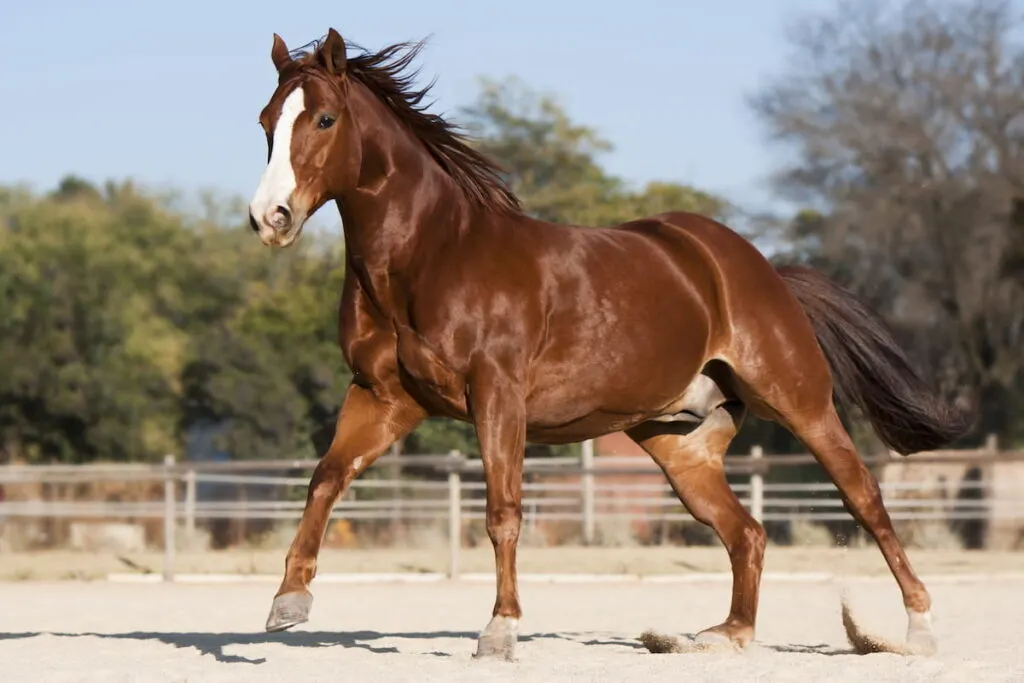
The American Quarter Horse is one of America’s most versatile and popular horse breeds – a well-deserved honor. The humble beginnings of the quarter horse began in the original American colonies.
For fun on the weekends, settlers raced their imported English farm horses down short, rough tracks – or sometimes down the center of town!
As time passed and horse racing became more serious (and legal), breeders began to select small, tough horses with powerful hindquarters. These “quarter-miler horses” became unmatched during short sprints over a quarter-mile distance.
As settlers moved west, the quarter horse became a popular ranch horse. With an innate “cow sense” and natural athletic ability, these horses became excellent at working cattle.
Today, you can find a quarter horse nearly anywhere – working the ranch, competing at rodeo events, crossing the open range on a long-distance trail ride, or even as a backyard family companion horse.
American Saddlebred
Average Height: 15-17 hands
Common Colors: Chestnut, bay, brown, black, gray with various white markings.
Type: Light Horse
Common Uses: Performance (riding and driving), pleasure riding, trail riding
Registry: American Saddlebred Horse Association
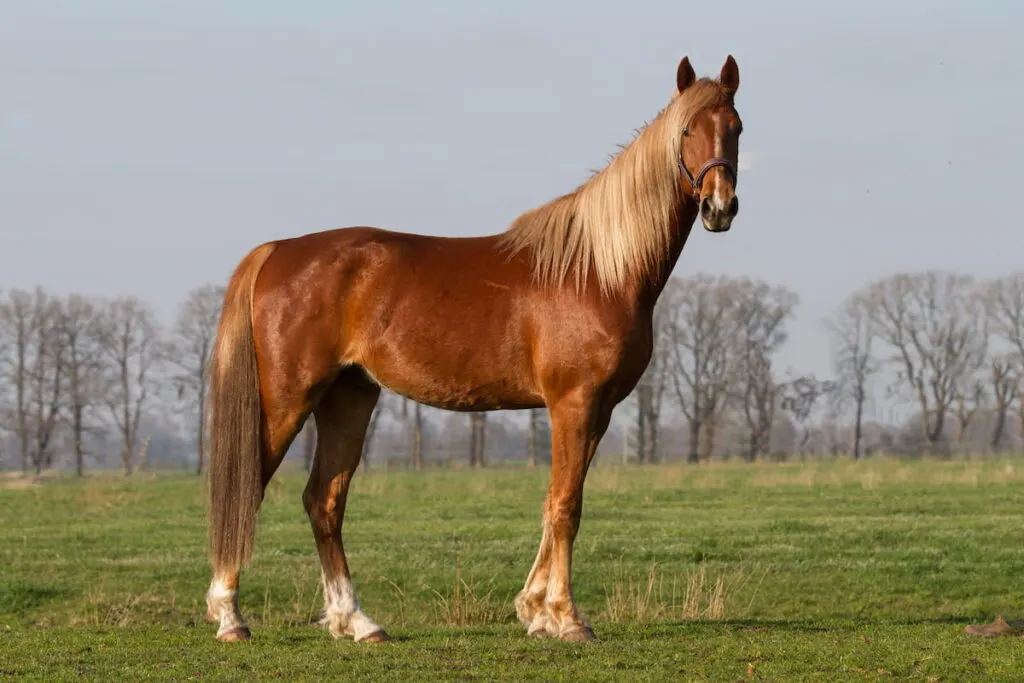
Known for their smooth gaits and good-natured personalities, American Saddlebred horses excel in the show ring and the lesson barn.
As English settlers brought their sleek carriage-pulling Thoroughbreds to America, they crossed them with the now-extinct Narragansett Pacer. This produced a high-stepping, elegant carriage horse that was well-suited for riding and driving.
In the South, the “American Saddle Horse” became bigger, flashier, and provided a more comfortable ride. The “Kentucky Saddler” developed to carry plantation owners efficiently and comfortably across their lands, and they were a favorite mount of officers in the Civil War.
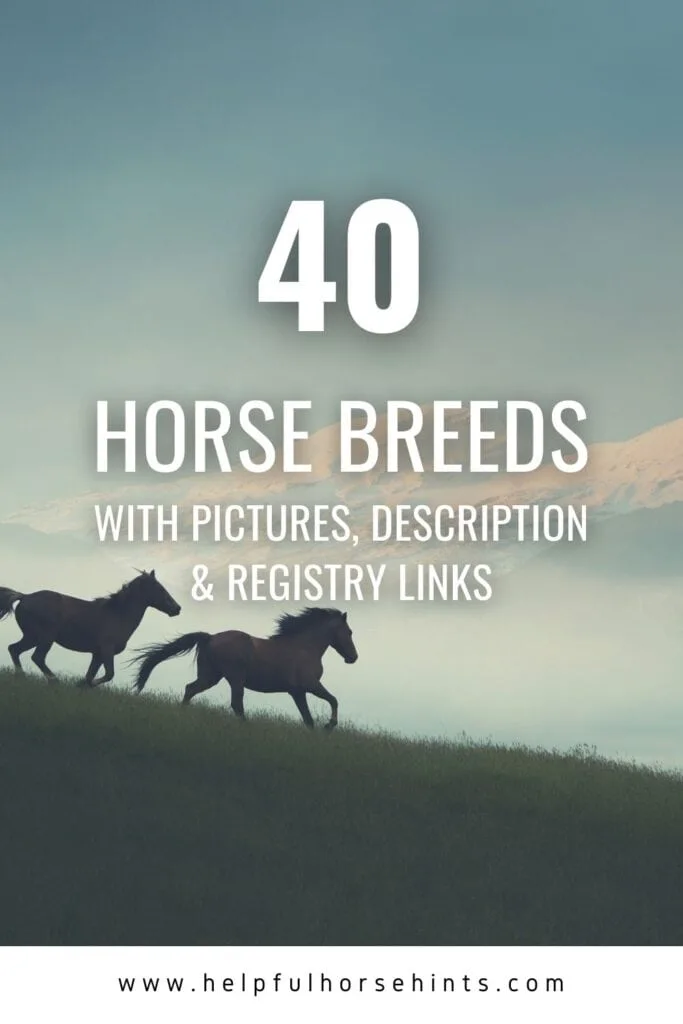
Saddlebreds are often gaited – they can walk, trot, canter, but many can perform ambling gaits as well (mostly the rack or slow gait). While you might generally see them in saddle seat performance rings, they are often shown in hunter classes or Western tack. American Saddlebreds are true pleasure horses – fun to ride, and a pleasure to be around.
Andalusian and Lusitano
Average Height: 15-16 hands
Common Colors: Only solid colors – mostly bay, gray, and black
Type: Light horse
Common Uses: Dressage, bullfighting (overseas), ranch work, performance
Registry: United States P.R.E Association and International Andalusian and Lusitano Horse Association
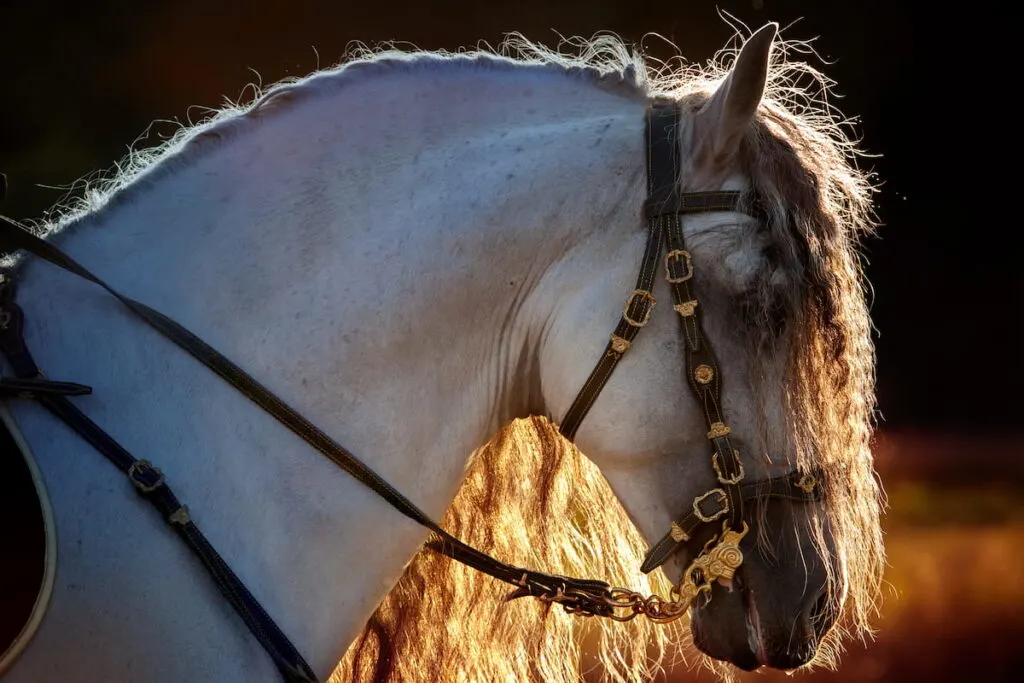
Some of the oldest horse breeds, these fine Spanish horses were some of the first to cross the vast Pacific Ocean into the Americas. Even before Roman times, elegant warhorses were used in Spain (and Lusitania) for hundreds of years for ranch work and bullfighting.
During the middle ages, horses were classified by type – and the light riding horses eventually became the fine Andalusian and Lusitano horses we see today.
These horses have a regal appearance, elastic gaits, and an excellent cow-sense. Affable and agile, they respond well to light aids, which is a necessary trait during a high-pressure situation (such as a bullfight) and for dressage.
There are herds of wild mustangs today that trace their ancestry back to these fine riding horses. Today, Andalusian and Lusitano horses make excellent dressage horses, although they are also popular in parades and in rodeos in South and Central America.
Appaloosa
Average Height: 14.2 – 16.2 hands
Common Colors: Solid body color (black, bay, chestnut, brown) with a recognized coat pattern (snowflake, blanket, leopard, etc.)
Type: Light horse
Common Uses: Ranch work, trail riding, performance, endurance
Registry: Appaloosa Horse Club
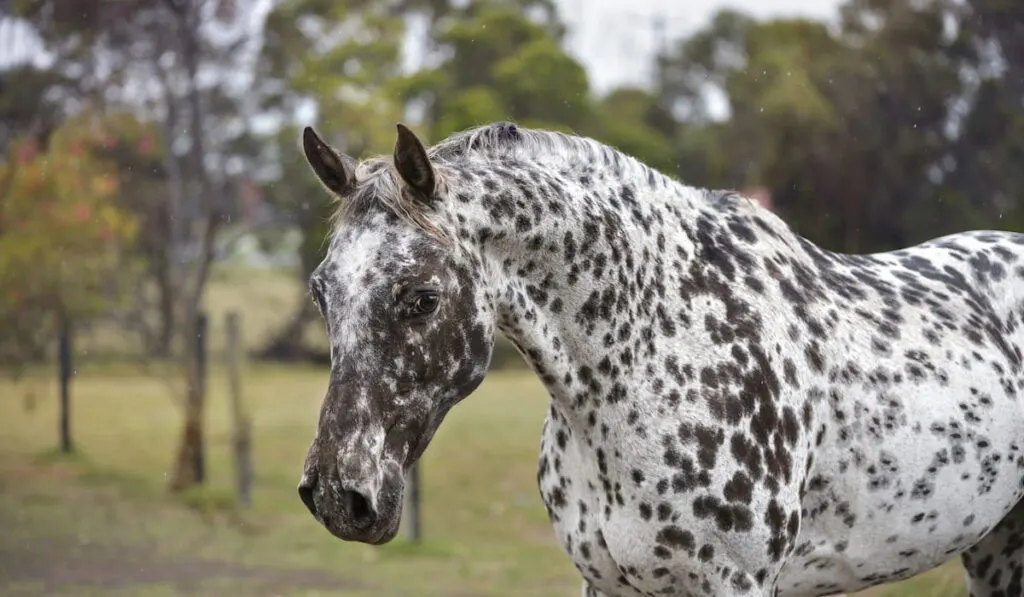
The uniquely spotted Appaloosa horse is a truly American breed. The Nez Perce people acquired spotted horses from descendants of Spanish bloodstock.
They began what would become a sophisticated breeding program for scrappy, hardworking range horses with good sense and tough feet.
An Appaloosa’s spots are caused by the leopard-complex, which is a set of genes that controls coat pattern expression. There are several different types of coat patterns including blanket, snowflake, leopard, or even solid! In fact, not all Appaloosas have spots – and not all spotted horses are Appaloosas.
In the 1800s, conflicts between the Nez Perce and the US government nearly wiped out the Appaloosa breed. Thanks to the concerted efforts of breed enthusiasts, the Appaloosa made a comeback.
Today, Appaloosas are one of the most popular breeds in the US, with over 650,000 registered individuals.
Arabian
Average Height: 14 – 15.3 hands
Common Colors: bay, gray, black, chestnut, roan
Type: Hot-blood
Common Uses: Endurance, dressage, jumping, performance, pleasure and trail riding
Registry: Arabian Horse Association
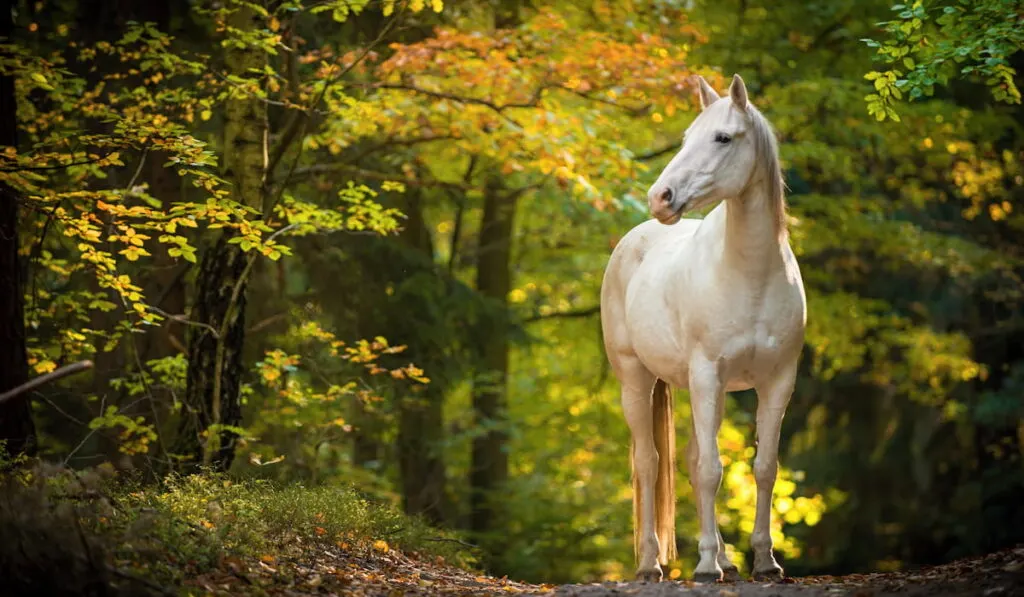
The Arabian horse is one of the oldest and most elegant horse breeds in the world. Thousands of years of meticulous breeding by the Bedouin tribes of the Arabian peninsula created a horse that was swift, loyal, and had excellent stamina. Arabians were so prized, the Bedouins often kept them in their tents to protect them from the elements, or thieves.
Today, Arabians are a versatile breed that excels in nearly any discipline. They dominate the field of competitive endurance riding and racing, and they can cover 50 miles of terrain in one day.
Shagya Arabians especially make excellent jumpers, and many can be trained for dressage.
You will more than likely find these intelligent and sensitive horses in the pleasure class division of local horse shows.
Their versatility and good temperaments make them one of the most popular horse breeds in the world – over 10,000 Arabian foals are registered every year in the US alone.
Belgian
Average Height: 16-18 hands
Common Colors: Chestnut or sorrel, with white mane and tail and white stockings
Type: Draft
Common Uses: Driving, pulling, agricultural work, performance, pleasure riding
Registry: Belgian Draft Horse Corporation of America
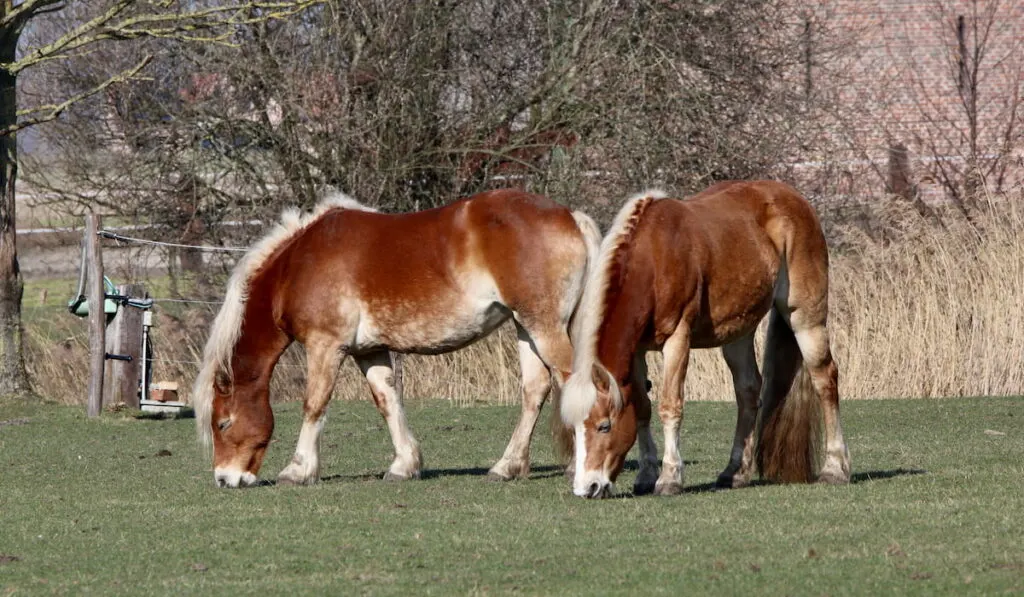
The Belgian breed arrived in America in the late 1800s, but in 1904, Belgium sent “an impressive array of horses” to the World’s Fair. This sparked a public interest in these heavy, docile horses that continues to this day.
In America, Belgians are often lighter and longer-legged than their Belgian-born cousins. You’ll often see them pulling carriages down city streets, or sleighs in winter. These gentle giants are relatively easy to handle, and can often be found under saddle in lesson programs or out on the trails.
Clydesdale
Average Height: 16.2-18 hands
Common Colors: Bay and brown, usually with wide face markings and white feet
Type: Draft
Common Uses: Pulling, driving, pleasure riding
Registry: Clydesdale Breeders of the USA
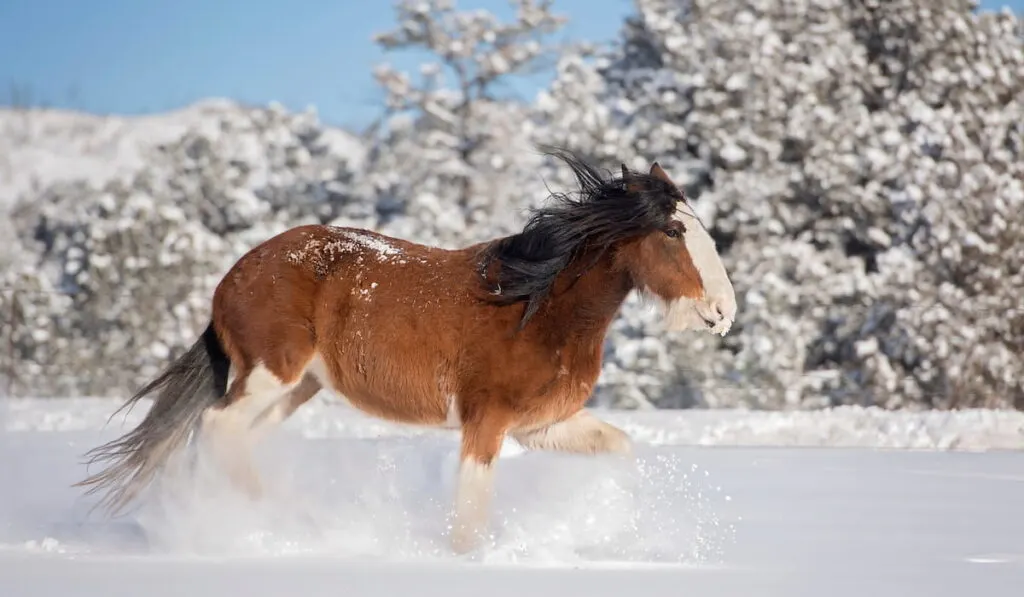
Originally from Scotland, the Clydesdale is a popular draft horse for agricultural work, driving, and also riding.
The Clydesdale breed was made famous in the US by the famous Budweiser horses – an 8-piece driving team that still appears in Super Bowl commercials today.
Many of the Clydesdales in America are actually descended from the Budweiser Clydesdale breeding program, which has had a significant impact on the breed as a whole. Clydesdales are tall and handsome, with large feathered feet and flashy high-knee action.
Colorado Rangerbred
Average Height: 14 – 16+ hands
Common Colors: Any color, often spotted with Appaloosa markings
Type: Light horse
Common Uses: Ranch work, endurance, rodeo events, performance, pleasure riding
Registry: Colorado Ranger Horse Association
The Colorado Rangerbred (or Colorado Range Horse) is a working ranch horse with cow smarts, endurance, and a good disposition. They also tend to have the trademark spots of an Appaloosa, but they are not strictly a color breed.
In 1878, General Ulysses S. Grant was gifted two exceptional stallions during a visit with his good friend, the Sultan of Turkey. One was an Arabian named Leopard, and the other was a Barb named Linden Tree.
Back home in the US, a friend of Grant bred these horses to a group of mares on his ranch, and the result was a group of fine ranch horses.
Today, all Colorado Rangerbreds are descendants of one of two foundation stallions from this foundation herd. Even though they are not a color registry, many Rangerbreds are spotted due to the aggressive line-breeding of spotted horses.
Rangerbreds are used in distance endurance riding, trail riding, and pleasure riding. They make excellent ranch horses, and are also good for working with cattle.
Dutch Warmblood
Average Height: 15.2 – 17 hands
Common Colors: Chestnut, gray, bay, black
Type: Warmblood
Common Uses: Jumping, Dressage, Driving
Registry: KWPN North America (Royal Dutch Sport Horse)
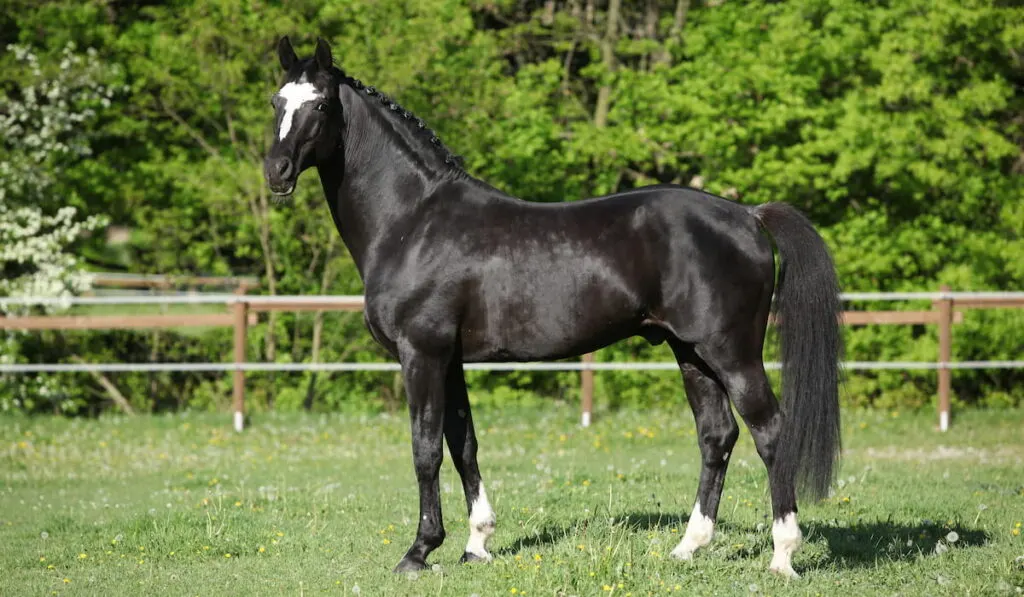
The Dutch Warmblood is known as one of the best sport horses in the world. Bred for speed, stamina, agility, and talent, the Dutch Warmblood can excel at nearly every equestrian discipline. They consistently perform in top levels of jumping and dressage competitions, including the Olympics.
The breed began in Holland, as the needs shifted away from heavy workhorses to lighter riding horses. After World War II, mechanized farming became the norm, and horses were used for recreation.
Breeders began to develop a horse with “traditional farm horse qualities of soundness, character, and willingness to work, while producing a riding horse with good gaits and a competitive spirit” (Dutson, 1996).
They are popular choices for sport and competition in the United States, and many are imported directly from Holland. One of several popular “warmblood” breeds, they are bred for performance, rather than for looks.
Fell Pony
Average Height: 13.2 Hands
Common Colors: Black (sometimes bay or brown)
Type: Pony
Common Uses: Driving, performance, pleasure riding, jumping
Registry: Fell Pony Society of North America
The Fell pony hails from northern England, where it served as a hardy pack pony since the times of the Ancient Romans. They are tough and athletic, and have excellent flowy gaits.
Today, they are increasing in popularity as a nice show pony, perfect for exhibiting under saddle or driven in harness. They also make great jumpers, and their quiet disposition also makes them easy to handle (even for the youngest riders).
Friesian
Average Height: 15 – 17 hands
Common Colors: Registered purebreds are always solid black
Type: Warmblood
Common Uses: Driving, dressage, performance
Registry: Friesian Horse Association of North America
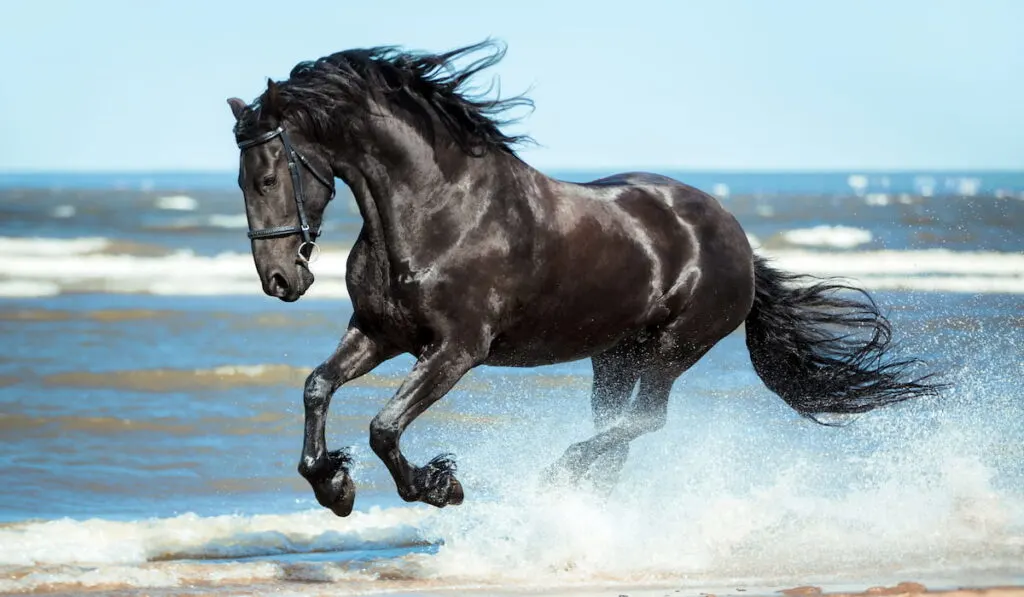
The magnificent Friesian is known for its rich black coat, full mane and tail, and sophisticated regal appearance and way of moving.
These majestic black horses also hail from Holland, where strict breeding regulations have maintained exceptionally pure bloodlines for generations.
A heavier horse, the Friesian came to America with Dutch settlers as a carriage horse in New York City in the late 1700s. Despite their thicker build, they have a floaty trot and square, fluid gaits. This makes them excellent at dressage.
Due to their striking appearance, these horses are also popular in movies and tv. If you see a solid black horse with feathered feet – especially in scenes involving medieval warhorses – it’s likely a Friesian horse actor.
Gypsy Vanner
Average Height: 14 – 15.2 hands
Common Colors: Piebald, skewbald, solid black or brown
Type: Light draft
Common Uses: Driving, dressage, pleasure riding
Registry: American Gypsy Horses and Gypsy Vanner Horse Society
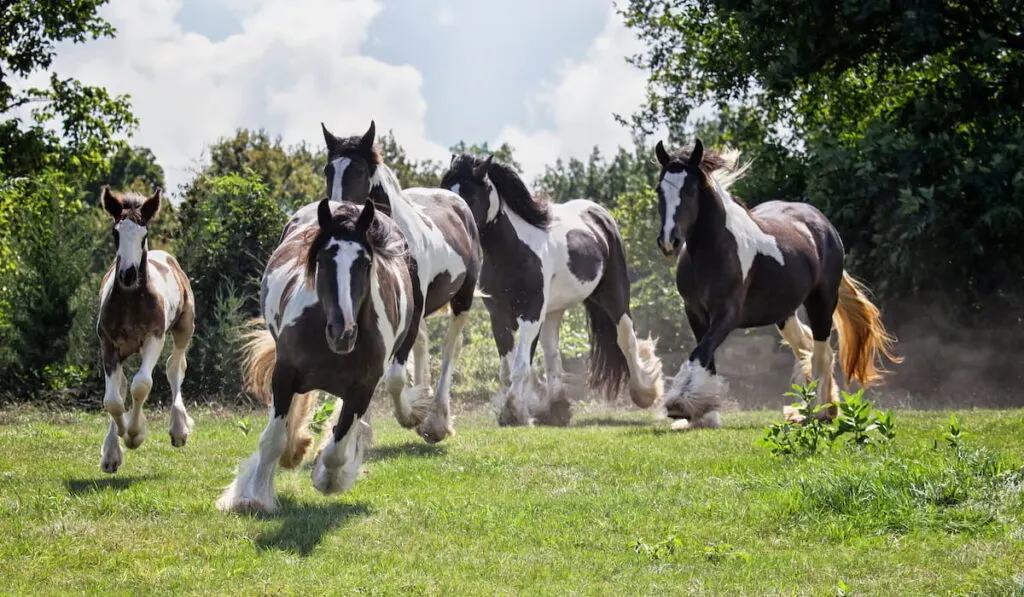
The Roma are an ethnic group of people that traditionally live and travel with horse-drawn carriages, pulled by striking painted horses.
The Roma people have maintained extensive oral pedigrees for their animals creating a well-mannered, easy-keeping, flashy carriage horse.
In the 1990s, the breed made its way to the United States, where it continues to grow in popularity. Gypsy Vanners are excellent driving horses, but they also can excel at dressage, on the trail, or as quiet mounts for lesson programs.
Hackney Horse and Hackney Pony
Average Height: 12.2—14.2 hands for ponies, 14.2 – 16 hands for horses
Common Colors: Black, brown, bay, chestnut
Type: Pony, Light horse
Common Uses: Driving, jumping, performance
Registry: American Hackney Horse Society
Horse-drawn carriages dominated the transportation industry during the 1800s, but it was expensive to keep horses in the city. As the need for a fashionable high-headed flashy carriage horse grew, the Hackney Horse was born.
A blend of Thoroughbred, Arabian, Cleveland Bay and Norfolk trotter, the Hackney is mostly known as an elegant harness horse with a high-stepping energetic trot.
The Hackney Horse breed itself is relatively rare in the US, with most of the 500 new animals a year being registered as Hackney ponies. But the breed registry does not separate horses and ponies, but Hackney horses must stand over 14.2 hands.
While they are known for their talent in harness, Hackney horses also make excellent jumpers and pleasure horses. You may also occasionally see them in open saddle seat competitions with Morgans and American Saddlebreds.
Haflinger
Average Height: 13 – 15 hands
Common Colors: Chestnut or sorrel
Type: Light draft
Common Uses: Farm work, pleasure riding, dressage
Registry: American Haflinger Registry
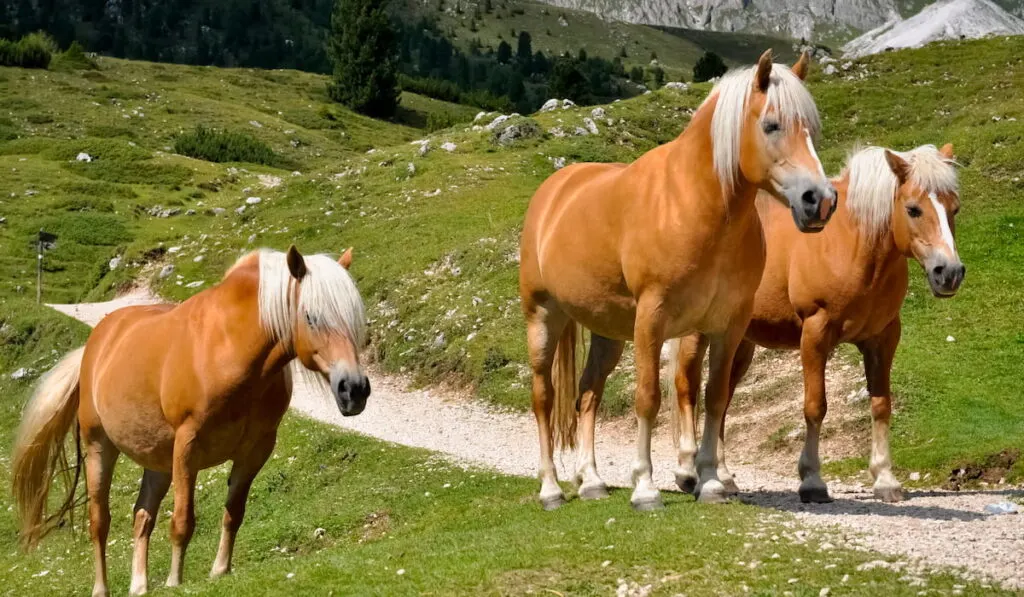
For hundreds of years, farmers in the Tyrolean area of Austria and northern Italy have used the small, stocky, good-natured chestnut Haflinger horse for plowing their rocky terrain.
Once referred to as the “tractor of the Alps”, these horses have powerful hindquarters and refined heads – “a prince up front, a peasant behind.”
They are always chestnut, although the shade range varies in depth and tone. All modern Haflingers can trace back to one stallion named Folie, who was a light chestnut color with a white mane and tail.
They are versatile horses, suitable for pleasure riding, light farm work, and dressage. Willing and eager to please, a Halflinger generally makes a great family mount.
Hanoverian
Average Height: 16 – 17.2 hands
Common Colors: Chestnut, but sometimes black, bay, or brown
Type: Warmblood
Common Uses: Dressage, jumping, combined driving
Registry: American Hanoverian Society
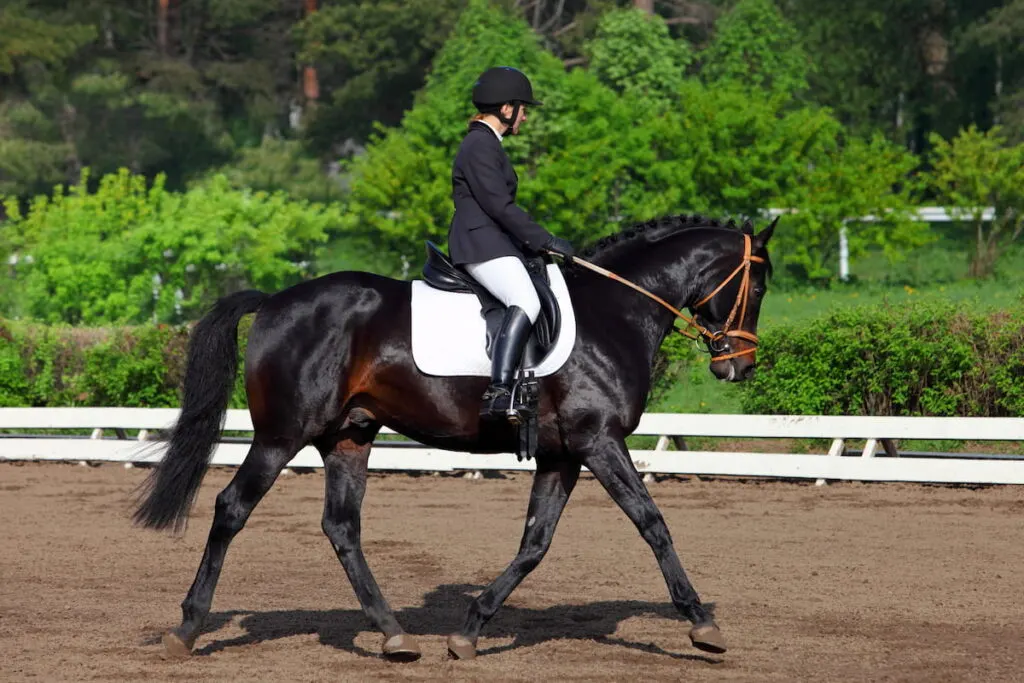
The Hanoverian began as a noble coach horse, hauling the aristocrats of the Holy Roman Empire in the 17th century. Later, they became excellent agricultural and cavalry horses.
Two types of Hanoverians appeared – heavier carriage horses and the lighter riding horses we’re most familiar with today.
Now, they are one of the most popular warmblood horse breeds across the globe. They are extremely athletic and versatile, excelling at all the Olympic equestrian events – dressage, show jumping, and combined driving.
Their good looks and effortless gaits also make the Hanoverian well-rounded in the hunter competition rings as well.
Holsteiner
Average Height: 16 – 17 hands
Common Colors: brown, black, bay
Type: Warmblood
Common Uses: Combined driving, jumping, dressage
Registry: American Holsteiner Horse Association
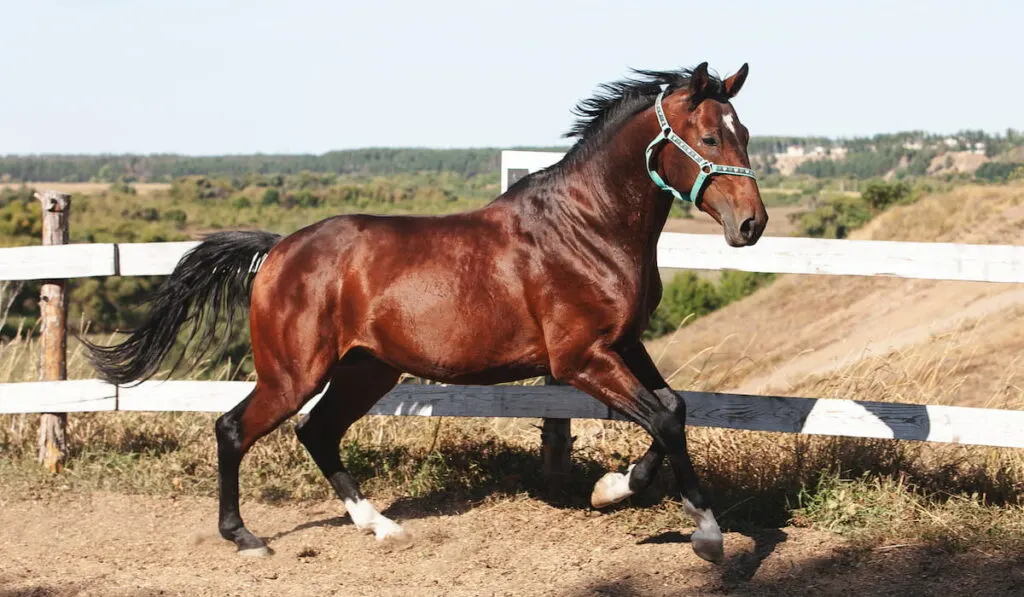
Early Holsteiner horses developed in the 13th century, plowing farms for German monasteries. France imported Holsteiners by the thousands to use as cavalry horses due to their stamina, strength, and good gaits.
Eventually, farming became mechanized, and the heavy artillery horses of World War II were no longer needed. So, breeders added Thoroughbred and Arabian bloodlines to turn the Holsteiner into a talented competition horse.
Holsteiners excel at show jumping, combined driving, and dressage. The registry maintains strict breeding requirements, which helps ensure that only quality bloodlines animals can continue.
Icelandic Horse
Average Height: 12.2 – 14.3 Hands
Common Colors: All colors and patterns are allowed
Type: Light horse
Common Uses: Pleasure riding, trail riding, trekking, endurance, dressage
Registry: United States Icelandic Horse Congress
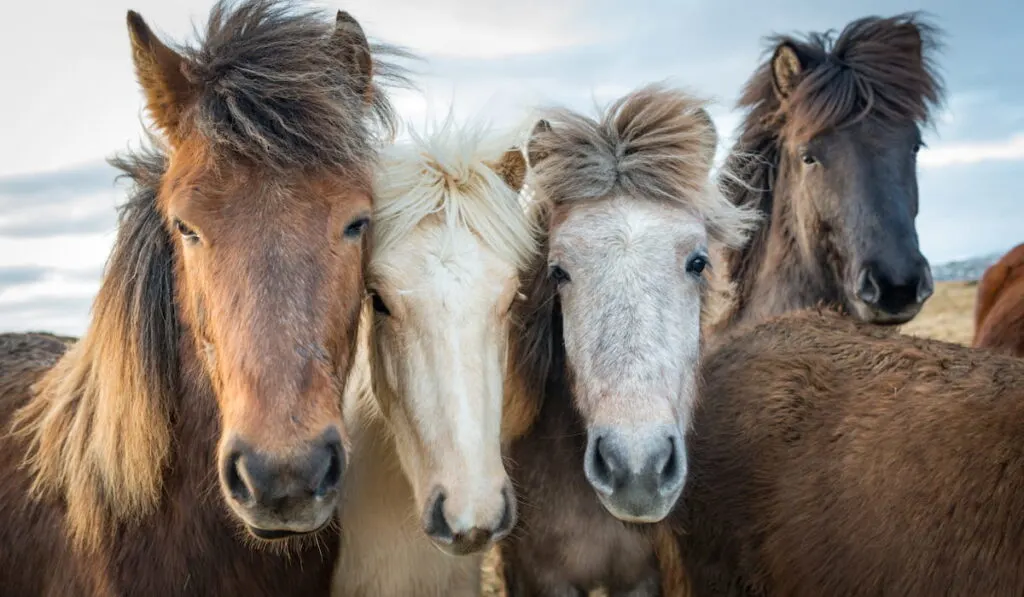
The roots of the Icelandic horse trace back to the time of the Vikings – and the breed has remained relatively unchanged for 1,000 years. Strict laws in Iceland prevent the import of any other horses, and these tough smooth-gaited little horses only began traveling to the United States in the 1950s.
Despite their small stature (only standing about 12-14 hands tall), they are considered horses, not ponies. Icelandic horses are known for their smooth gaits, and the breed itself is gaited.
They can walk, trot, and canter like most horses. But, Icelandics have two more: the tolt (a four-beat ambling gait) and the flying pace.
They are agreeable and tough, and make excellent mounts for children, beginners, or those with joint problems who might be looking for a smoother ride. They excel in endurance, trekking, trail riding, and can often be found in low-level dressage or hunter rings.
Kentucky Mountain Saddle Horse and Mountain Pleasure Horse
Average Height: 11 – 15.2 hands
Common Colors: Any solid color is accepted
Type: Light horse
Common Uses: Pleasure riding, trail riding
Registry: Kentucky Mountain Saddle Horse Association and Mountain Pleasure Horse Association
Like the Tennessee Walking Horse, the Kentucky Mountain Saddle Horse was bred to be a comfortable, sure-footed trail horse to work small farms.
These small but tough little mountain horses developed from the necessity of a good family horse – even little kids and grandpa would often climb aboard.
Gentle and smooth, these adorable gaited-horses excel at trail riding and general pleasure riding. If you’re looking for something a little less flashy than a TWH but just as comfortable and sure-footed, consider a Kentucky Mountain Saddle Horse or its slightly taller cousin, the Mountain Pleasure Horse.
Miniature Horse
Average Height: Under 34” and Under 38”
Common Colors: Any color, including flashy pintos or spotted Appaloosas
Type: Light horse
Common Uses: Companion animal, driving, agility
Registry: American Miniature Horse Association
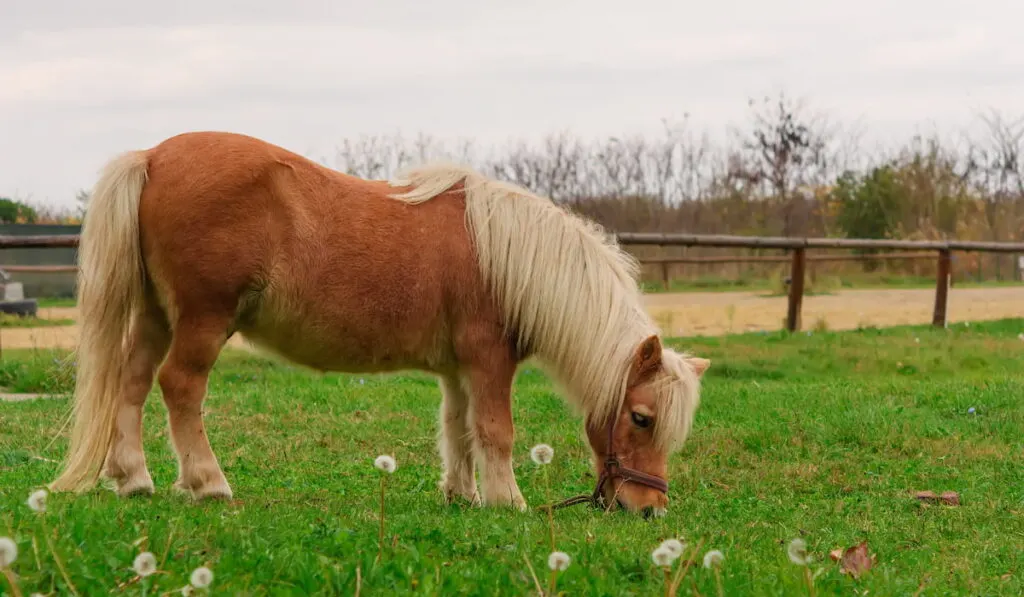
Miniature horses were bred as pets for the English nobility, and pulled heavy carts laden with coal for the English working class. Small, sturdy, and full of attitude, Miniature Horses are technically considered horses – not ponies.
They are the only breed measured at the base of the mane, rather than at the withers. A Mini must measure below 34” for Division A and below 38” for division B. They often look very much like full-sized horses with horse-like proportions – but in a small package.
At my barn, we affectionately call them “expensive lawn ornaments.” Although, these intelligent animals can be used to pull carts, in free-jumping or agility, and may be ridden by children.
Miniature horses the only other animals (other than dogs) recognized by the ADA that can become official service animals.
Missouri Fox Trotter
Average Height: 14 – 16 hands
Common Colors: Bay, black, brown, chestnut, pinto, buckskin, cremello, palomino, champagne
Type: Light horse
Common Uses: Ranch work, trail riding, pleasure riding, therapeutic riding
Registry: Missouri Fox Trotting Horse Breed Association
Another gaited mountain breed, the Missouri Fox Trotter is a comfortable ranch and trail horse with a sweet disposition.
Known more for their surefootedness than their flashy movements, these horses are commonly found on the trail or in backyard farms. They’re even used by the U.S Forest Service to cover thousands of miles of trails and open land.
Missouri Fox Trotters are excellent trail horses because the footfalls of their fox-trot gait keep a low-profile to the ground. They’re exceptionally surefooted, even when the rocky ground of the Ozarks is particularly rocky.
Morgan
Average Height: 14.1 – 15.2 hands (may reach 16+ on occasion)
Common Colors: Bay, black, brown, chestnut
Type: Light horse
Common Uses: Pleasure riding, trail riding, performance, driving, ranch work, jumping
Registry: Morgan Horse Association
One of the most influential horse breeds in America, the Morgan is an elegant and versatile horse with a humble origin story.
In 1792, Justin Morgan was given a plucky little horse named Figure. Though he was scarcely 14 hands, he could out-pull, out-perform, and out-run every opponent matched against him.
He was also an excellent driving horse with good gaits – and he passed many of these fine traits on to his offspring. Many of these traits are still evident today in the Tennessee Walking Horse, Saddlebred, and Standardbred.
Today, Morgans make wonderful pleasure horses for riding or driving. They stand out in the show ring with their fine good looks, but they also make excellent trail and family riding horses as well.
Mustang
Average Height: 13.2 – 15 hands
Common Colors: Any and all
Type: Light horse
Common Uses: Trail riding, endurance, pleasure riding
Registry: Wild Horse and Burro Program and a list of other organizations on the Mustang Breed Profile
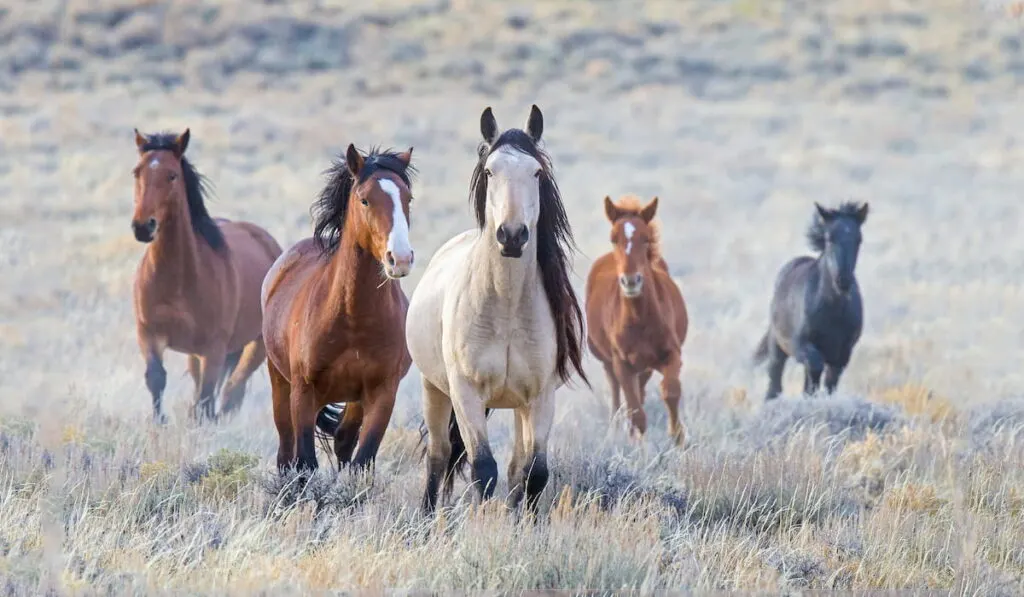
When Christopher Columbus and the other conquistadors sailed to the New World, they brought their fine Spanish horses with them. As more Europeans settled in the Americas, their horses were often sold, stolen, or escaped (not many corrals in those days!).
After hundreds of years of natural selection, herds of wild horses now roam the American West. They are managed by the Bureau of Land Management, and many are rounded up and adopted to private homes every year.
Mustangs are relatively small, scrappy, and surefooted. Because they are not truly wild horses (just feral), if tamed, a mustang can be an excellent companion – especially out on the trails. They are intuitive and intelligent, but it can take an experienced handler to earn their trust.
Every year, mustang events are held around the country to show off the talents of these versatile wild horses. There are also several different specific types of mustangs, and each one has a specific history and defining characteristics.
National Show Horse
Average Height: 14 – 17 hands
Common Colors: Any and all colors
Type: Light horse
Common Uses: Performance, pleasure riding, driving
Registry: National Show Horse Registry
What do you get when you cross the high-stepping action and grace of an American Saddlebred with the elegance and endurance of an Arabian? A breed born for excellence in the performance ring.
The National Show Horse exhibits the best qualities from both breeds – the presence and refinement of an Arabian, and the brilliant motion of a Saddlebred. While people were unofficially crossing these two breeds for a long time, now there is a registry for approved sires and dams.
While the registry is open to any of the three foundation breeds to produce National Show Horse foals, they still must be approved for breeding by the National Show Horse Registry for the foal to be registered as an NSH.
Norwegian Fjord
Average Height: 13.2 – 14.2 hands
Common Colors: Always dun, with primitive dorsal and leg stripes
Type: Light draft
Common Uses: Pleasure riding, driving, trail riding, endurance, jumping, performance
Registry: Norwegian Fjord Horse Registry
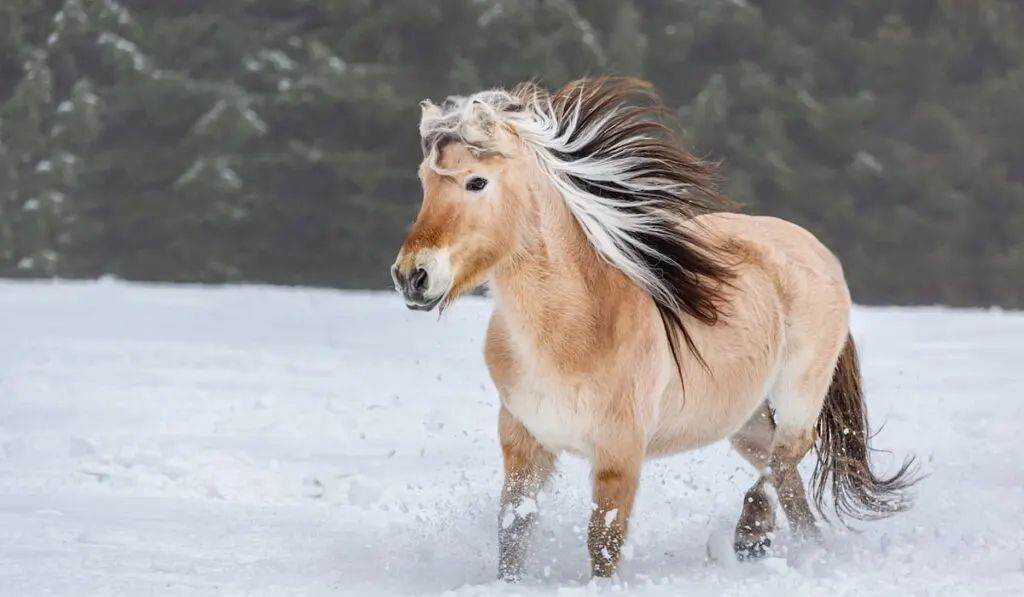
The hardy little Fjord horse was traditionally used in Norway for farm work, driving, riding, and navigating the harsh rocky climate.
These horses have a distinct look that sets them apart from other breeds, including primitive markings and a stiff, mohawk-like mane.
These versatile horses are increasingly popular in America, where they’re used for driving, jumping, endurance riding, or as an all-around family horse.
Their small stature and gentle disposition often make them good choices for children, but they’re strong enough to carry adults as well.
Oldenburg
Average Height: 16—17.2 hands
Common Colors: Bay, brown, black, gray
Type: Warmblood
Common Uses: Jumping, dressage, eventing, driving
Registry: Oldenburg Registry North America and International Sporthorse Registry
The Oldenburg is an all-purpose riding horse whose roots began as a fine German carriage horse. These horses excel at equestrian sports, and you can often find them in the winning Olympic circles of show jumping, eventing, and dressage.
These are well-bred horses, and the breed association has a saying, “quality is the only standard that counts.” Thus, you may have several Oldenburgs that vary slightly in type and conformation. Despite this, they are bold horses with expressive gaits, and they excel in the performance arena.
Paso Fino
Average Height: 14 –15 hands
Common Colors: All colors are except Appaloosa
Type: Light horse
Common Uses: Performance, trail riding, pleasure riding
Registry: Paso Fino Horse Association
The words “Paso Fino” literally translate to “fine step” in Spanish – and the Paso Fino horse has some of the finest steps around.
This elegant breed developed in Puerto Rico during the time of the conquistadors. Breeders crossed their gaited Spanish Jennets with trotting Andalusians.
The result was a fine riding horse with an agreeable temperament, flashy movement, and a very particular set of unique gaits (the paso fino, the paso corto, and the paso largo are commonly exhibited in the show ring).
The strides are very short, and the horse moves at various speeds without covering much ground – it almost looks like they’re dancing.
Percheron
Average Height: 16-18 hands
Common Colors: Black and gray
Type: Draft
Common Uses: Driving, agricultural work, Pleasure riding
Registry: Percheron Horse Association of America
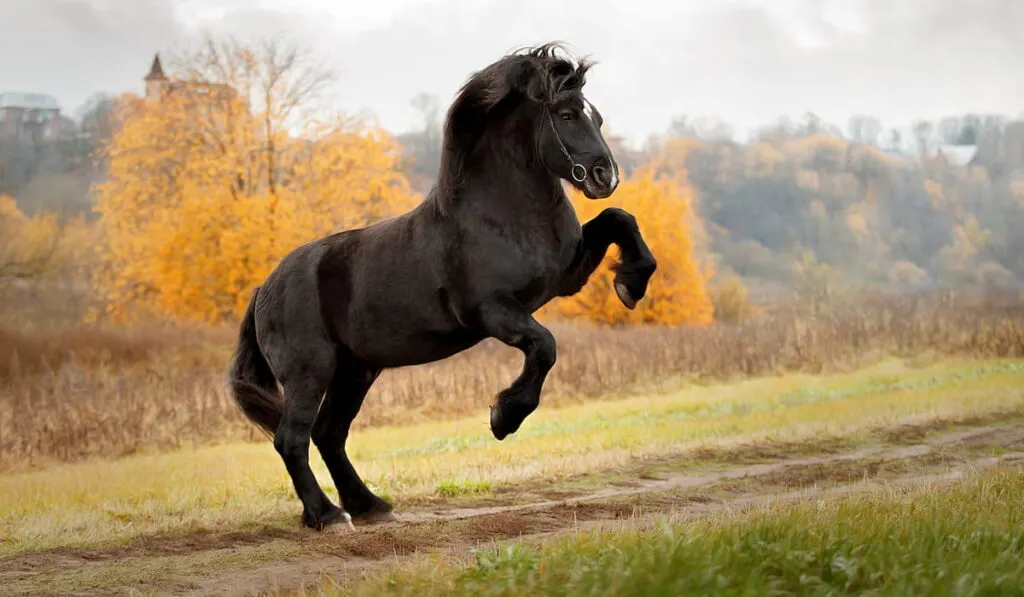
In the La Perche region of France, heavier working farm horses were crossed with lighter Arabians and Thoroughbreds to produce an elegant coach horse. Their ancestors served as warhorses during the crusades.
Percherons are popular and versatile draft horses in the US, often appearing in harness but also under saddle. They lack the heavy feathering of the legs of other draft horses, and can be found in performance rings in many disciplines, from carriage pulling to dressage!
Peruvian Paso
Average Height: 14 – 15 hands
Common Colors: bay, black, brown, buckskin, chestnut, dun, gray, palomino
Type: Light horse
Common Uses: Trail riding, performance, pleasure riding
Registry: North American Peruvian Horse Association
The Peruvian Paso is a smooth-gaited horse suitable for trail or pleasure riding or exhibiting in the show ring. Like many other ancient Spanish breeds, the Peruvian Paso developed from the need for a comfortable riding horse over rough terrain.
When people spent much of their time on horseback, they wanted comfortable horses with ground-covering ambling gaits. As roads improved and carriages became more popular, trotting horses became the norm.
In Peru, they wanted a smooth horse with a brilliant spirit. The Peruvian Paso is known for the unique action of its termino, which is a natural rolling movement of the front leg during their ambling gait. Performance Peruvian Pasos are shown barefoot to showcase their natural abilities, wearing no shoes or other aids.
Pony of the Americas
Average Height: hands 11.2 – 14 hands
Common Colors: Any, but must have visible spots
Type: Pony
Common Uses: Western events, endurance, eventing, driving, jumping, pleasure riding
Registry: Pony of the Americas Club

One of the most popular pony breeds, the Pony of the Americas is an American-born cross between the Shetland Pony, the Appaloosa, and the Arabian. A POA must have a spotted coat visible from forty feet away.
These versatile ponies are good-natured and easily trained and succeed in many disciplines. Their versatility makes them popular choices for children or small adults (or tall adults who want to show a POA in-hand).
Racking Horse
Average Height: 15.2 hands (on average)
Common Colors: Bay, black, brown, chestnut, gray, sorrel, palomino, pinto
Type: Light horse
Common Uses: Performance, pleasure horse, trail riding
Registry: Racking Horse Breeders Association of America
Like many other American gaited breeds, the Racking Horse developed as an answer for crossing large Southern plantations in comfort and style. After racing fell out of favor (although it would later become popular again), Racking Horse owners turned to shows to exhibit the skills of their comfortable breed.
Racking Horses are known for their “rack,” a single-foot ambling gait that can quickly cover large amounts of ground. Unlike Tennessee Walking Horses or American Saddlebreds, Racking Horses are shown without big shoes or tail sets, and correct form and speed are prized over flashy knee action.
Rocky Mountain Horse
Average Height: 14.2 – 16 hands
Common Colors: Always a solid color, often a unique chocolate liver chestnut, or blue roan.
Type: Light horse
Common Uses: Trail riding, pleasure riding, ranch work
Registry: Rocky Mountain Horse Association
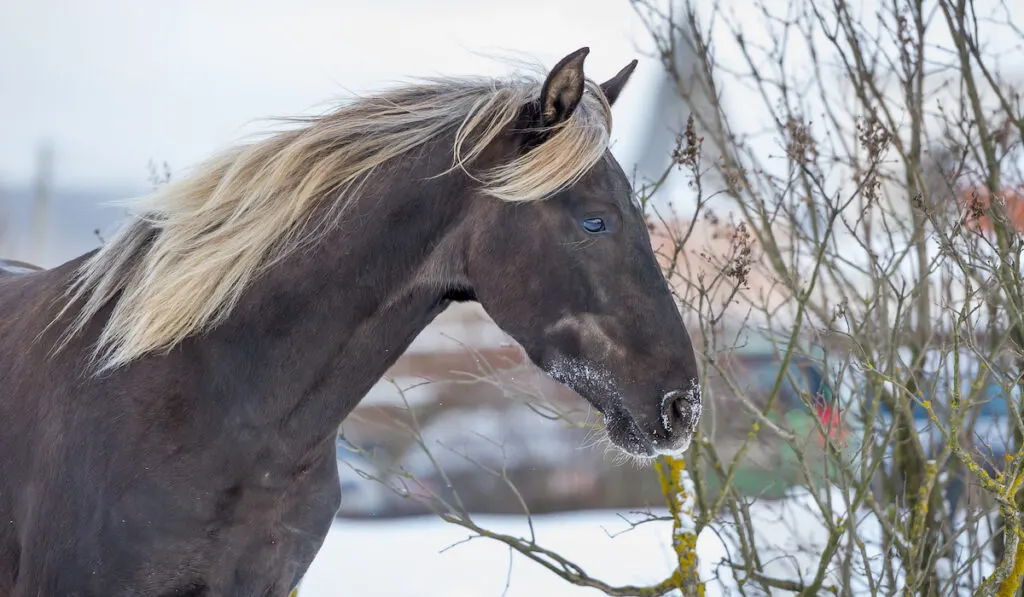
Like the Kentucky Mountain Saddle Horse and the Mountain Pleasure Horse, the Rocky Mountain Horse was born in the slippery hills of Kentucky and Tennessee. Like the others, this breed is also gentle, surefooted – and gaited.
Most Rocky Mountain Horses only have two gaits: the walk and the single-foot. They have the ability to canter, but many find that the single-foot gait is fast enough to get where they need to go without cantering.
Selle Francais
Average Height: 16 – 16.3 hands
Common Colors: chestnut, bay
Type: Warmblood
Common Uses: Showjumping, dressage, eventing
Registry: Studbook Selle Francais North America
These robust sport horses from France often dominate the show jumping arena at the highest levels of competition. Like many athletic warmbloods, the Selle Francais began as a powerful carriage and cavalry horse.
Today, they consistently rank in the top 5 in the WBFSH show jumping rankings (source). They’re often known for their gentle natures and great affection towards their handlers.
Shetland Pony
Average Height: Under 11.2 hands
Common Colors: All colors, except Appaloosa
Type: Pony
Common Uses: Jumping, driving, children’s riding pony
Registry: American Shetland Pony Club
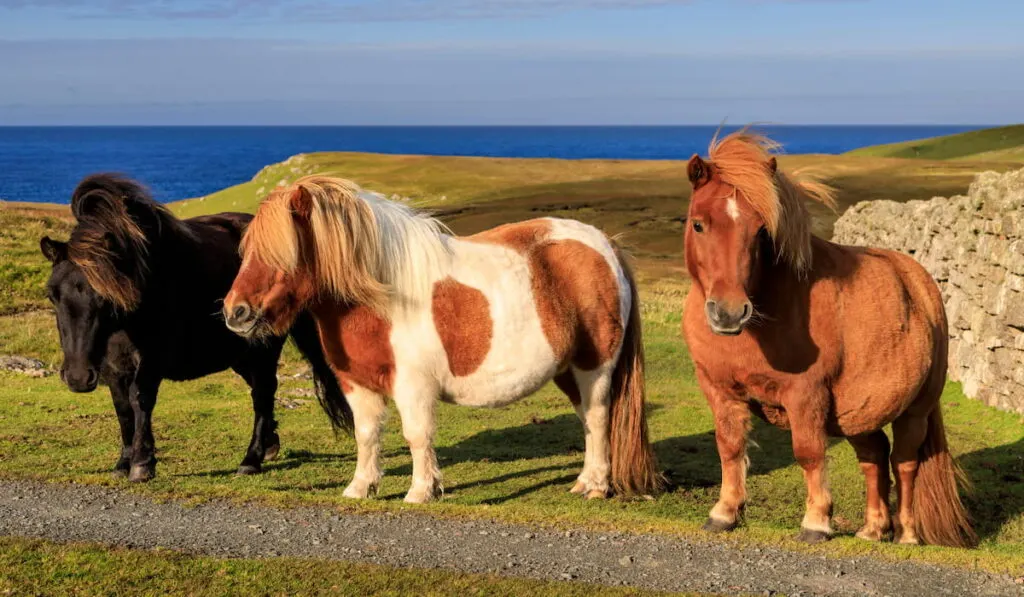
Shetland ponies are small, hardy little ponies that are popular mounts for children. Originally from the British Shetland Islands, these ponies worked in the coal mines after child labor was outlawed.
Today, Shetland ponies make excellent family companions. They do well under saddle with children, but are also popular driving choices for adults.
Shire
Average Height: 16.2 – 19 hands
Common Colors: Black, brown, bay, gray, chestnut
Type: Draft
Common Uses: Pulling, driving, performance, farm work
Registry: American Shire Horse Association
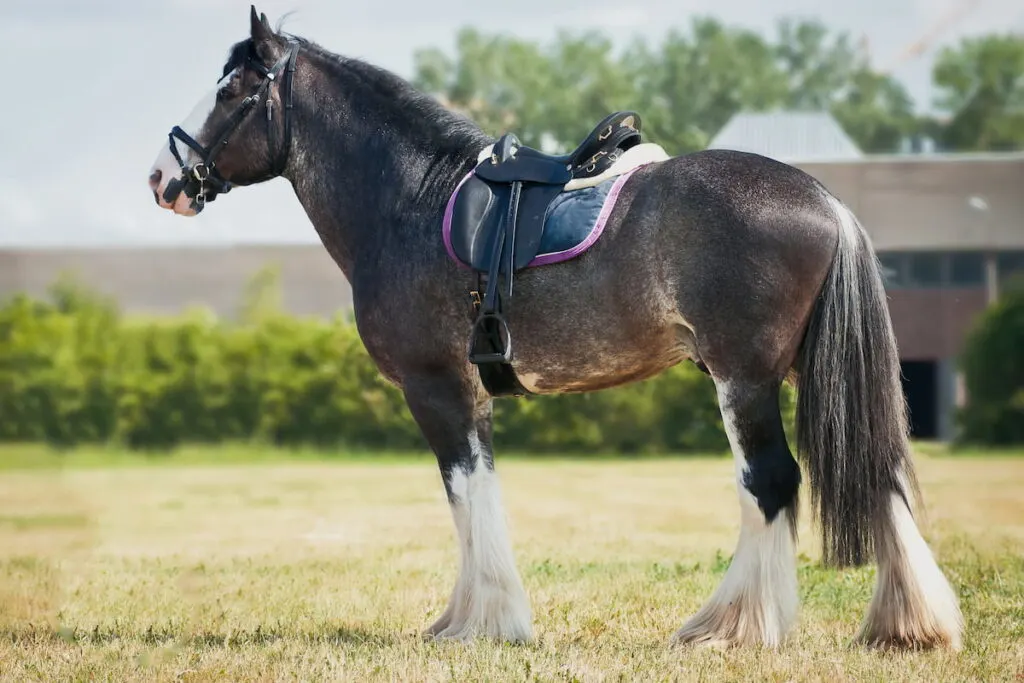
The Shire horse is often considered the “Rolls Royce” of draft horses. These large, heavy horses were used in England for hundreds of years as strong pack and plow animals, making their way to the Americas in the 1800s. They’re known for their exceptional size, regal appearance, and large feathered feet.
They’re commonly used as logging horses, able to reach areas that mechanical equipment still cannot reach. They’re also a common sight at fairs and shows in pulling and driving competitions. Because they possess excellent movement, they are also often crossed with Thoroughbreds to produce talented jumpers.
Standardbred
Average Height: 15 – 15.3 hands
Common Colors: Bay, brown, black
Type: Light horse
Common Uses: Harness racing, pleasure riding, driving
Registry: United States Trotting Association
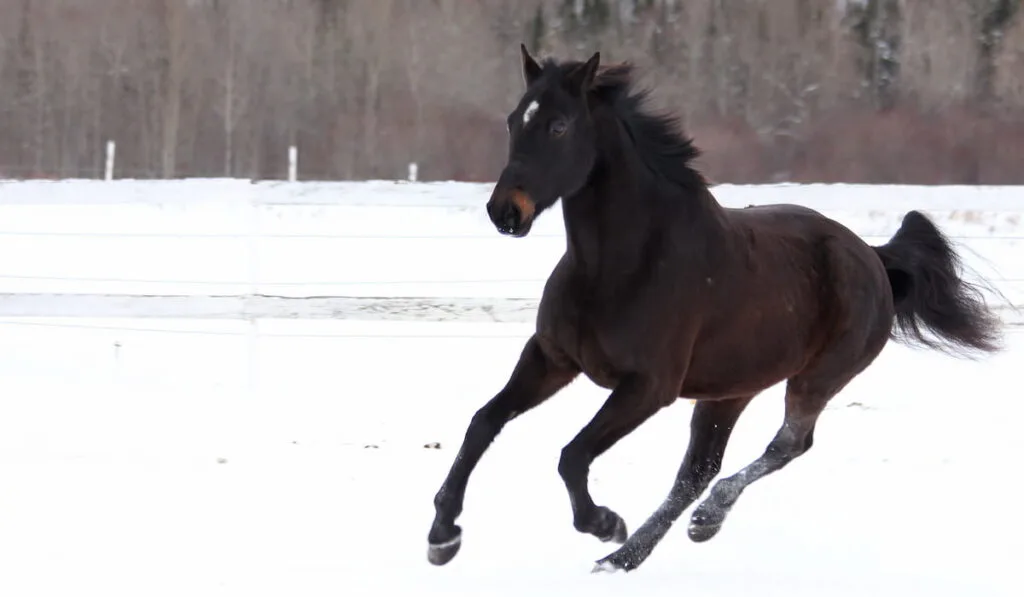
In the early days of the Americas, there were no well-paved roads for wheeled vehicles. Settlers relied on their horses to get them from place to place, and many regularly traveled over long distances.
Because of this, many horses in the Americas during the early colonial times were smooth-gaited. In New England, trotting Dutch and English horses fell out of favor to pacers because it was more comfortable over long distances, although not quite as comfortable as the ambling horses in the South.
Eventually, some of these trotting and pacing races became popular, under saddle and in harness. The Standardbred was a horse that could pace a mile in a standard time of 2 minutes and 25 seconds (2:30 for the trotters), hence the name Standard–bred.
The ability to trot or pace is actually determined by a gene, which scientists have recently identified as the DMRT3. Now, breeders can theoretically test young Standardbred racehorses and determine whether their career will be more successful as a pacer or a trotter. Off the track, the Standardbred is often used as a pleasure or buggy horse.
Tennessee Walking Horse
Average Height: 14.3 – 17 hands
Common Colors: Any solid color, also pinto
Type: Light horse
Common Uses: Performance, trail riding, pleasure riding
Registry: Tennessee Walking Horse Breeders and Exhibitors Association
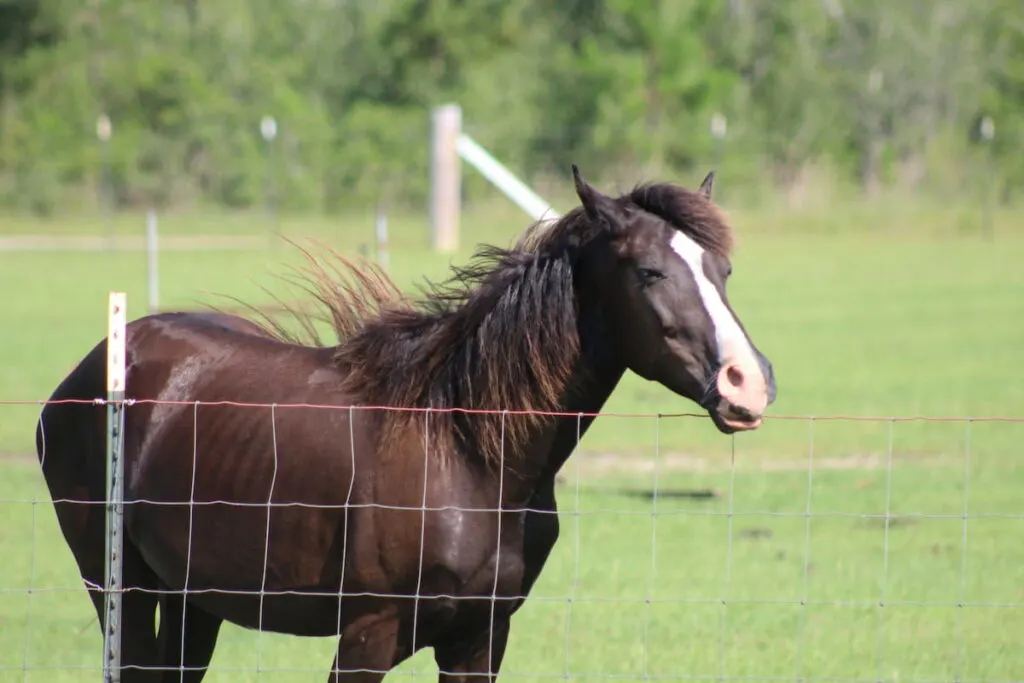
The Tennessee Walking Horse is best known for its ground-covering “running walk” which may look pretty odd to the non-equestrian. It’s a gait that they perform naturally, with hundreds of years of careful breeding behind them.
The first Tennessee Walking Horses developed when southern plantation owners crossed American pacing breeds with elegant gaited Spanish horses. After adding some graceful American breeds to the mix (Saddlebreds, Thoroughbreds, and Morgans), the TWH breed was born.
They are popular in the performance ring, showing off their flashy running walk in saddle seat and Western pleasure classes. However, they also make great trail horses – providing their owners with a smooth and comfortable ride.
Thoroughbred
Average Height: hands 15 – 17 hands
Common Colors: Chestnut, bay, brown, black, gray
Type: Hot-blood
Common Uses: Racing, eventing, jumping, competition
Registry: The Jockey Club
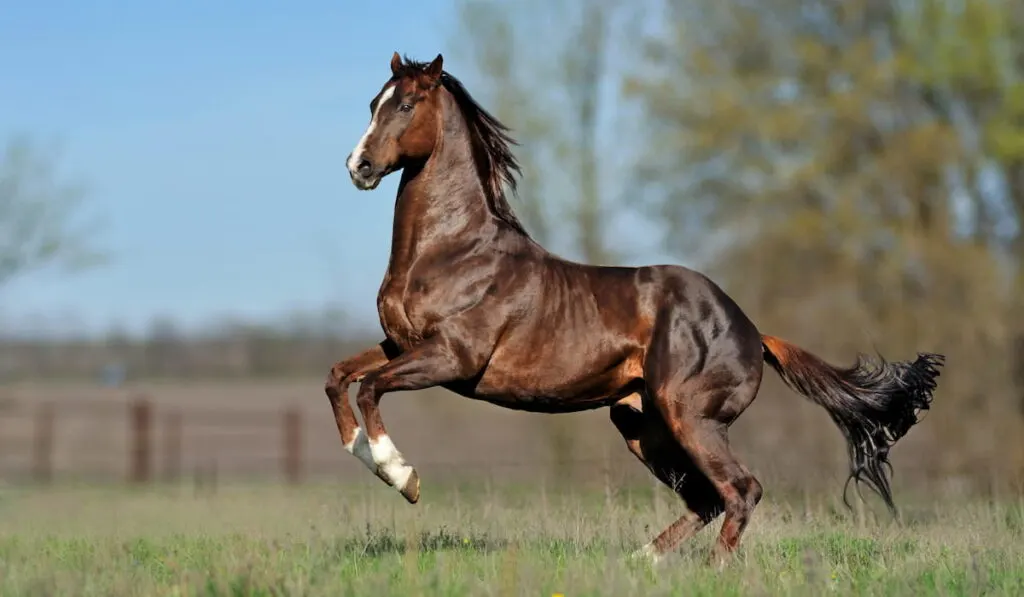
The Thoroughbred is a long, lean, racing machine. Born in England at the very end of the 17th century, three imported stallions became the foundation sires for what is arguably one of the most popular and influential horse breeds in history.
- The Godolphin Arabian was from Morocco, and likely a Barb (not actually an Arabian, in fact).
- The Darley Arabian came from some of the finest racing Arabian stock in present-day Syria.
- The Byerly Turk was probably from an ancient breed we now call the Akhal-Teke, a swift desert breed known for their shiny metallic coats.
All Thoroughbreds registered with the Jockey Club can trace back their lineage to these three important stallions. Horse racing (and breeding specific horses for racing) had been a popular English pastime for the past 500 years. Adding these new imported stallions produced high-quality racehorses that were also heavily used as riding horses as well.
Racing was popular in the United States at this time as well – except the short, stocky American Quarter Horses kept winning against the long-legged Thoroughbreds. As the racing industry changed (and actually became legal), flatter and longer tracks were built.
Thoroughbreds are tall, graceful, and athletic horses with heart. They are exceptionally well-muscled, but not thick.
Hundreds of failed racehorses retire from the racing industry each year, and many are able to excel in other disciplines such as jumping, eventing, and dressage. These are called “off the track thoroughbreds”, although not all Thoroughbreds in the US are bred just for racing.
Thoroughbreds are one of the most popular breeds in the US, and also one of the most popular cross-breeds as well. If you’re looking for a talented athlete with a little fire in his belly, consider a Thoroughbred or Thoroughbred cross!
Trakehner
Average Height: 16 – 17 hands
Common Colors: Chestnut (also bay, black, brown, gray)
Type: Warmblood
Common Uses: Dressage, eventing, jumping, sporthorse competition
Registry: American Trakehner Association
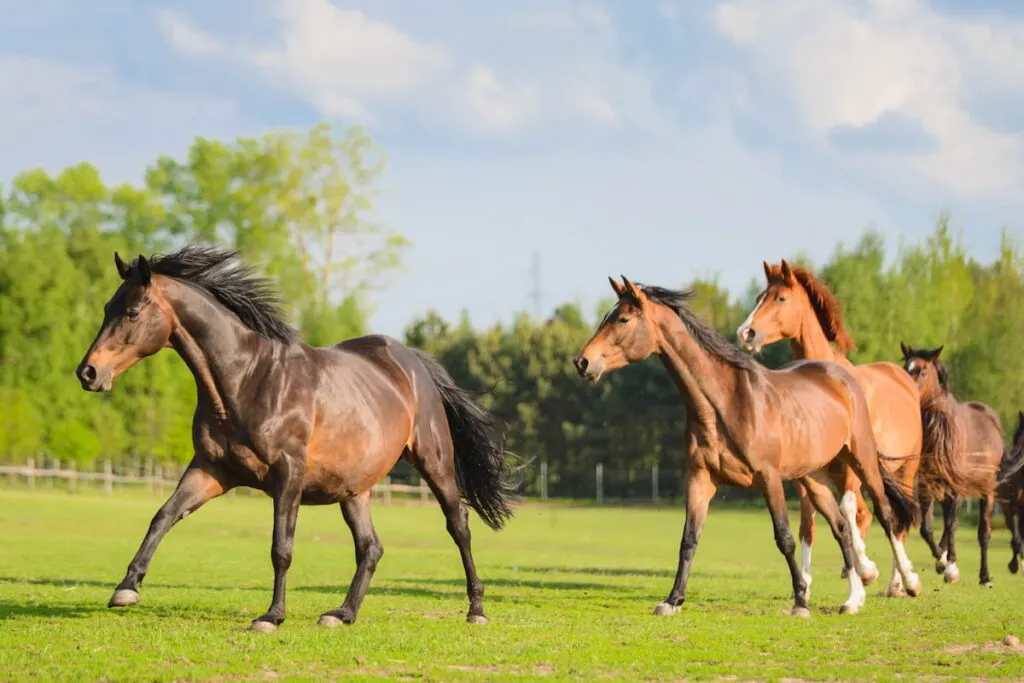
The Trakehner is one of the only true warmblood breeds. With a closed studbook, they have a distinct type –these horses have excellent conformation, “compelling presence, and nobility of bearing.”
At the end of World War II, hundreds of Trakehners traveled across the frozen Baltic sea, fleeing from Soviet forces. Only the strongest survived, and these individuals built the athletic and noble horse that exists today.
Trakheners are elegant and powerful, and known for their talents in dressage. With an endurance that makes them successful at the top levels of competition, they also excel in eventing as well.
Westphalian
Average Height: 16 – 17 hands
Common Colors: Any color, often chestnut, bay, black, gray
Type: Warmblood
Common Uses: Jumping, dressage, pleasure riding
Registry: Westphalians for USA
Like the rest of the warmblood breeds you can find in the US, the Westphalian horse is exceptionally athletic. This breed also excels at dressage and show jumping.
Strict breeding requirements dictate that only the finest animals are accepted for breeding, and most of them come from the Westphalen stud directly from Germany.
However, they are successful in the US as talented jumping horses, and they are known for their sweet natures. Someone looking for a successful lower-level competition mount should consider a Westphalian, due to their good-natures and all-around talents.
Welsh Pony and Welsh Cob
Average Height: 11 -13.2 hands (pony), 13.2 hands and up (cob)
Common Colors: Gray, brown, chestnut
Type: Pony, Light Horse, Draft
Common Uses: Jumping, driving, pleasure riding
Registry: Welsh Pony and Cob Society of America
These horses trace back to those used on the rocky farmland hills of Wales. Tough and athletic, they come in three types that are classified by height: the Welsh Mountain Pony (under 12 hands), the Welsh Pony and Welsh Pony Cob Type (under 13.2 hands), and the Welsh Cob (13.2 hands and up – often reaching 16 hands).
They have pleasant dispositions and are easily trainable, making them suitable for a variety of different jobs. Smaller Welsh ponies and cobs are often seen in the pony jumper rings, and large draft cobs are often used for driving.
Resources
http://www.americangypsyhorses.com/

